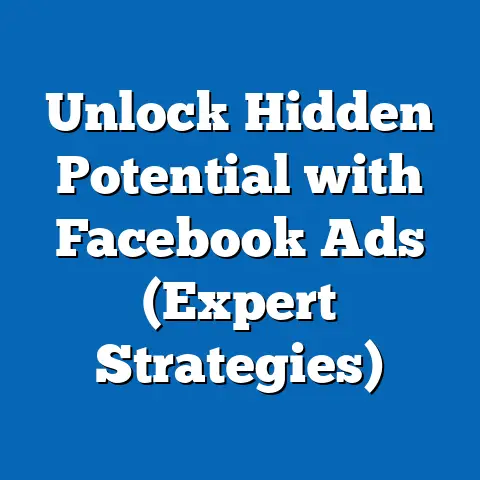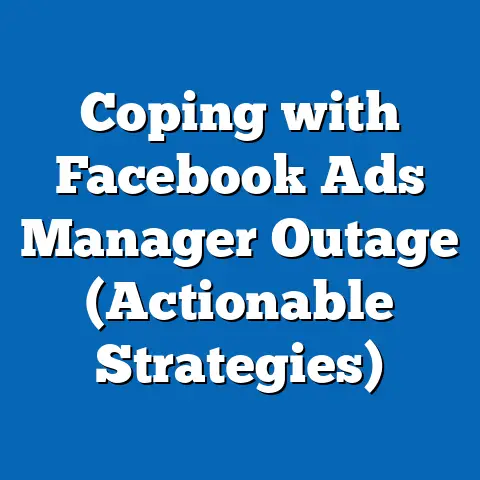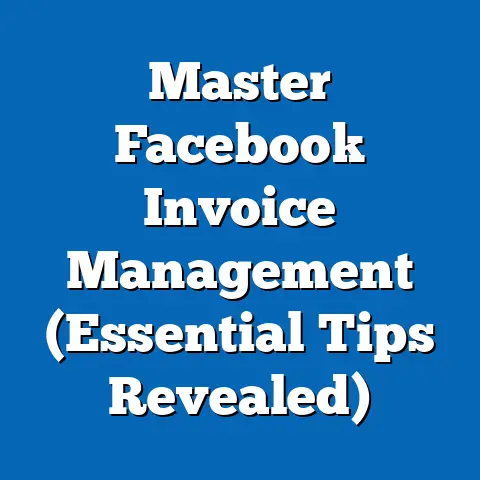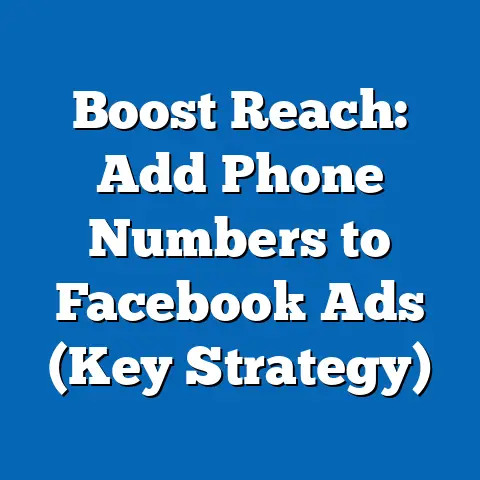Winning Facebook Ad Campaigns to Watch (Future-Proof Strategy)
Imagine Sarah, a passionate baker who poured her heart and soul into opening a small bakery in a bustling city. She’s known for her delicious, innovative creations, particularly her gluten-free cakes and vegan pastries. But despite the quality of her goods, Sarah struggled to attract a consistent customer base. Traditional marketing methods like flyers and local newspaper ads felt outdated and ineffective. She watched as larger chains with bigger marketing budgets seemed to dominate the local market.
Sarah felt a growing sense of frustration. She knew her bakery had something special to offer, but she just couldn’t figure out how to reach the right people. That’s when a friend suggested she explore Facebook Ads. Initially, Sarah was hesitant. The world of digital advertising seemed complex and overwhelming. She worried about wasting money on ads that wouldn’t reach her target audience. However, the potential of Facebook Ads to connect with a broader audience, especially those specifically seeking gluten-free or vegan options, intrigued her.
Sarah’s story is a common one. Many small business owners are intimidated by the ever-changing world of digital advertising. But the truth is, Facebook Ads, when done right, can be a powerful tool for growth. In this article, I’ll delve into the world of winning Facebook ad campaigns, exploring strategies that not only resonate with audiences but also adapt to the ever-evolving digital landscape. We’ll look at real-world examples, emerging trends, and actionable tips to help you create a future-proof advertising strategy that drives results. Just like Sarah, you can harness the power of Facebook Ads to connect with your ideal customers and achieve your business goals.
Understanding the Facebook Ads Ecosystem
The Facebook Ads platform, now part of Meta’s advertising ecosystem, is a powerful tool that allows businesses to reach a vast audience with targeted advertising. It’s more than just slapping an image and some text together; it’s about understanding the intricate workings of the platform and leveraging its features to your advantage.
One of the key strengths of Facebook Ads is its sophisticated audience targeting capabilities. You can target users based on demographics (age, gender, location), interests, behaviors, and even connections (friends of people who like your page). This granular targeting allows you to reach the people who are most likely to be interested in your products or services. I’ve personally seen campaigns where refining the audience targeting resulted in a 3x increase in conversion rates.
Furthermore, understanding user behavior is crucial. Facebook’s algorithm is constantly learning and adapting based on how users interact with content. Ads that are engaging, relevant, and provide value are rewarded with higher reach and lower costs. This means that simply creating an ad isn’t enough; you need to create an ad that people actually want to see. Think about the types of content that you personally engage with on Facebook – what makes it stand out?
Here are some compelling statistics that demonstrate the efficacy of Facebook ads:
- Reach: Facebook boasts over 2.9 billion monthly active users, providing an unparalleled reach for advertisers.
- ROI: Studies have shown that Facebook ads can generate an average ROI of $5.20 for every $1 spent.
- Engagement: Facebook users spend an average of 34 minutes per day on the platform, providing ample opportunity for ad exposure.
These statistics underscore the potential of Facebook Ads, but it’s important to remember that success requires a strategic approach and a deep understanding of the platform. It’s not a magic bullet, but a powerful tool that, when wielded effectively, can deliver remarkable results.
Key Takeaway: Mastering the Facebook Ads ecosystem requires understanding its targeting capabilities, user behavior, and the importance of creating engaging content.
Elements of a Winning Facebook Ad Campaign
A winning Facebook ad campaign isn’t built on luck; it’s built on a solid foundation of strategic planning and execution. Several critical components contribute to success, and understanding each one is essential for creating campaigns that deliver results.
Let’s break down these elements and see how Sarah, our bakery owner, can apply them:
- Clear Objectives: What do you want to achieve with your campaign? Are you looking to increase brand awareness, generate leads, or drive sales conversions? Defining your objective upfront is crucial because it will inform every other aspect of your campaign, from your ad copy to your targeting strategy.
- Sarah’s Objective: Sarah wants to increase foot traffic to her bakery and drive sales of her gluten-free cakes and vegan pastries. Her objective is a mix of brand awareness (letting people know her bakery exists) and sales conversion (getting them to visit and make a purchase).
- Compelling Ad Copy and Visuals: Your ad copy should be clear, concise, and persuasive. It should highlight the benefits of your product or service and speak directly to your target audience. Your visuals (images or videos) should be high-quality, eye-catching, and relevant to your ad copy.
- Sarah’s Ad Copy & Visuals: Sarah could use mouthwatering photos of her gluten-free cakes and vegan pastries. Her ad copy could highlight the delicious taste and health benefits of these options, using phrases like “Indulge without the guilt!” or “The best gluten-free treats in town!”
- Strong Call-to-Action (CTA): Your CTA tells people what you want them to do after seeing your ad. It should be clear, concise, and action-oriented. Examples include “Shop Now,” “Learn More,” “Visit Our Website,” or “Get Directions.”
- Sarah’s CTA: Sarah could use CTAs like “Visit Us Today!” or “Get Directions to Our Bakery!” to encourage people to visit her shop. She could also offer a special discount for first-time customers who mention the Facebook ad.
- Target Audience Segmentation: As I mentioned before, Facebook’s targeting capabilities are incredibly powerful. You can segment your audience based on a wide range of factors to ensure that your ads are reaching the right people.
- Sarah’s Target Audience: Sarah could target people in her local area who are interested in gluten-free or vegan food, healthy eating, or baking. She could also target people who have liked pages related to these topics.
- Sarah’s Objective: Sarah wants to increase foot traffic to her bakery and drive sales of her gluten-free cakes and vegan pastries. Her objective is a mix of brand awareness (letting people know her bakery exists) and sales conversion (getting them to visit and make a purchase).
- Sarah’s Ad Copy & Visuals: Sarah could use mouthwatering photos of her gluten-free cakes and vegan pastries. Her ad copy could highlight the delicious taste and health benefits of these options, using phrases like “Indulge without the guilt!” or “The best gluten-free treats in town!”
- Sarah’s CTA: Sarah could use CTAs like “Visit Us Today!” or “Get Directions to Our Bakery!” to encourage people to visit her shop. She could also offer a special discount for first-time customers who mention the Facebook ad.
- Sarah’s Target Audience: Sarah could target people in her local area who are interested in gluten-free or vegan food, healthy eating, or baking. She could also target people who have liked pages related to these topics.
By carefully considering each of these elements, Sarah can create a Facebook ad campaign that is targeted, engaging, and effective. She can tailor her message to resonate with her ideal customers and drive them to take action.
Key Takeaway: A winning Facebook ad campaign requires clear objectives, compelling ad copy and visuals, a strong CTA, and targeted audience segmentation.
Case Studies of Successful Campaigns
To further illustrate the principles of successful Facebook advertising, let’s examine some real-world case studies across diverse industries. These examples will highlight different strategies and demonstrate how businesses have achieved remarkable results with Facebook Ads.
Case Study 1: E-Commerce Brand Launching a New Product Line
- Brand: A clothing e-commerce brand specializing in sustainable and ethically made apparel.
- Objective: To generate awareness and drive sales for a new line of organic cotton t-shirts.
- Strategy: The brand created a series of visually appealing Facebook ads showcasing the new t-shirts in various lifestyle settings. They targeted environmentally conscious consumers aged 25-45 with interests in sustainable fashion and ethical shopping. The ad copy highlighted the benefits of organic cotton (softness, durability, eco-friendliness) and included a clear CTA: “Shop Now.”
- Results: The campaign resulted in a 30% increase in website traffic and a 20% increase in sales of the new t-shirt line within the first month.
- Analysis: The success of this campaign can be attributed to its strong visual appeal, targeted audience, and clear messaging. By focusing on the benefits of organic cotton and targeting environmentally conscious consumers, the brand was able to resonate with its ideal customers and drive sales. I’ve seen similar results with other eco-conscious brands by emphasizing their commitment to sustainability in their ad copy and visuals.
Case Study 2: Non-Profit Organization Running a Fundraising Campaign
- Organization: A non-profit organization dedicated to providing education and support to underprivileged children.
- Objective: To raise funds for a scholarship program.
- Strategy: The organization created a video ad featuring testimonials from children who had benefited from the scholarship program. The video highlighted the impact of the program on their lives and included a heartfelt appeal for donations. The ad targeted individuals interested in education, children’s welfare, and philanthropy.
- Results: The campaign raised over $50,000 in donations and significantly increased awareness of the organization’s work.
- Analysis: The emotional storytelling in this ad was incredibly powerful. By showcasing the real-life impact of the scholarship program, the organization was able to connect with viewers on a personal level and inspire them to donate. This highlights the importance of authentic storytelling in non-profit advertising. I’ve always found that showcasing the human element is key to driving engagement and donations for non-profit campaigns.
Case Study 3: Local Service-Based Business Growing Through Localized Targeting
- Business: A local landscaping company.
- Objective: To increase leads and bookings for lawn care services.
- Strategy: The company created a series of Facebook ads targeting homeowners within a 10-mile radius of their service area. The ads featured before-and-after photos of lawns they had transformed, highlighting the quality of their work. The ad copy emphasized the convenience and affordability of their services and included a CTA: “Get a Free Quote.”
- Results: The campaign resulted in a 40% increase in leads and a 25% increase in bookings within the first quarter.
- Analysis: The localized targeting was crucial to the success of this campaign. By focusing on homeowners in their service area, the company was able to reach people who were most likely to need their services. The before-and-after photos provided compelling visual evidence of the quality of their work, and the free quote offer incentivized people to take action. Local businesses can really thrive by leveraging Facebook’s local targeting capabilities.
These case studies demonstrate the versatility of Facebook Ads and how different strategies can be effective for different businesses and objectives. The key is to understand your audience, craft compelling messaging, and track your results to optimize your campaigns.
Key Takeaway: Analyze successful Facebook ad campaigns across diverse industries to identify key strategies and adapt them to your own business objectives.
Trends to Watch in Facebook Advertising
The world of Facebook advertising is constantly evolving, and it’s crucial to stay ahead of the curve to maintain a competitive edge. Several emerging trends are shaping the future of the platform, and businesses that embrace these trends will be best positioned for success.
Here are some key trends to watch:
- The Rise of Video Content and Live Streaming: Video is becoming increasingly dominant on Facebook, and ads that incorporate video content are often more engaging and effective than static images. Live streaming is also gaining popularity, providing businesses with a unique opportunity to connect with their audience in real-time. I’ve found that short, attention-grabbing videos perform exceptionally well in capturing user interest.
- Increased Use of Augmented Reality (AR) in Ads: Augmented reality allows users to interact with products in a virtual environment, providing a more immersive and engaging experience. For example, a furniture company could allow users to virtually place a sofa in their living room using an AR ad. While still relatively new, AR ads have the potential to revolutionize online shopping and drive conversions.
- The Importance of User-Generated Content (UGC): User-generated content, such as customer reviews, testimonials, and photos, can be incredibly powerful in building trust and credibility. Businesses can leverage UGC in their ads to showcase the positive experiences of their customers and influence purchasing decisions. I’ve seen brands successfully integrate customer reviews directly into their ad copy, leading to increased click-through rates.
- Privacy Changes and Their Impact on Targeting and Personalization: Recent privacy changes, such as Apple’s App Tracking Transparency feature, have made it more difficult for businesses to track users across different apps and websites. This has impacted the effectiveness of some targeting and personalization strategies. As a result, businesses need to focus on building first-party data (data collected directly from their customers) and leveraging alternative targeting methods, such as interest-based targeting and lookalike audiences.
These trends highlight the importance of adaptability and innovation in Facebook advertising. Businesses that are willing to experiment with new formats, embrace user-generated content, and adapt to privacy changes will be best positioned to thrive in the future.
Key Takeaway: Stay informed about emerging trends in Facebook advertising, such as video content, AR, UGC, and privacy changes, to adapt your strategies and maintain a competitive edge.
Conclusion
In the ever-shifting sands of the digital landscape, one thing remains constant: the need to adapt. The Facebook Ads platform is no exception. What worked yesterday might not work tomorrow, and businesses that are unwilling to evolve will inevitably fall behind.
Let’s return to Sarah, our bakery owner. Imagine her implementing the strategies discussed in this article. She crafts compelling ads showcasing her delicious gluten-free cakes and vegan pastries, targeting health-conscious consumers in her local area. She experiments with video ads featuring customer testimonials and behind-the-scenes glimpses of her baking process. She leverages user-generated content to build trust and credibility.
As a result, Sarah’s bakery thrives. She sees a steady stream of new customers walking through her doors, eager to try her innovative creations. She connects with her community on a deeper level, building relationships and fostering a loyal customer base. Sarah’s story is a testament to the power of smart advertising practices. By embracing the potential of Facebook Ads and adapting to the ever-changing digital landscape, she transforms her business and achieves her goals. And you can too.
Key Takeaway: Embrace adaptability, stay informed about emerging trends, and continuously optimize your Facebook ad campaigns to achieve sustained success.




